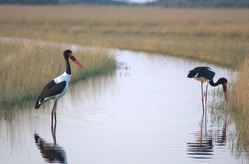Okavango Delta, Botswana
The Okavango Delta is among the most biologically diverse places on the planet. Protected by decades of Angolan civil war in the north and sheer remoteness in the south, this is the world’s largest inland delta. It also represents one of the last undisturbed conservation opportunities.
In August 2014, Adventure Scientists’ Executive Director Gregg Treinish and three other National Geographic Explorers traversed the delta, traveling with members of the local baYei tribe in traditional dugout canoes known as mokoros. The group of scientists, filmmakers and photographers encountered charismatic and heart-stopping megafauna, among them crocodiles, hippos and lions.





The delta is listed as one of the Seven Natural Wonders of Africa, and on June 22, 2014, it gained UNESCO World Heritage protection—the 1,000th site on that list. However, it is not immune to outside threats. Massive irrigation schemes are planned nearby in Namibia and Angola, and Chinese-funded agricultural development will soon introduce pesticides and fertilizers to the watershed.
Working with partners including the Wild Bird Trust and the Office for Creative Research, the expedition laid the groundwork for ongoing conservation engagement. While there, Gregg scouted a future AS project in which volunteers will live and work alongside the baYei, gathering essential information on the health of the delta, including data on wildlife and water quality.
“Our volunteers will be on the front lines collecting information UNESCO and the Wild Bird Trust can use to ensure this ecosystem remains intact,” Gregg said.
Gregg’s expedition partners are South African conservationist Dr. Steve Boyes; Office for Creative Research co-founder Jer Thorp; and engineer and conservation technologist Shah Selbe. During the traverse, the team established research platforms that now record video and audio, as well as other environmental conditions.

Learn more about this expedition at intotheokavango.org
